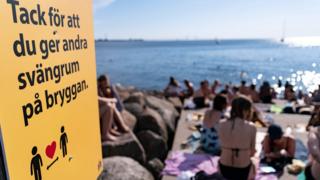Sweden’s economy less hard-hit by coronavirus
 Image copyright AFP
Image copyright AFP Sweden, which avoided a lockdown during the height of the Covid-19 pandemic, saw its economy shrink 8.6% in the April-to-June period from the previous three months.
The flash estimate from the Swedish statistics office indicated that the country fared better than other EU nations which took stricter measures.
However, it was still the largest quarterly fall for at least 40 years.
The European Union saw a contraction of 11.9% for the same period.
Individual nations did even worse, with Spain seeing an 18.5% contraction, while the French and Italian economies shrank by 13.8% and 12.4% respectively.
«The downturn in GDP is the largest for a single quarter for the period of 1980 and forward,» Statistics Sweden said.
«It is, as expected, a dramatic downturn. But compared to other countries, it is considerably better, for instance if you compare to southern Europe,» said Nordea bank chief analyst Torbjorn Isaksson.
Sweden has largely relied on voluntary social distancing guidelines since the start of the pandemic, including working from home where possible and avoiding public transport.
Although businesses have largely continued to operate in Sweden, the country’s economy is highly dependent on exports, which were hit by lack of demand from abroad during the pandemic.
Despite the contraction, Sweden is not yet in recession, since the first quarter saw growth of 0.1%.
An economy is generally deemed to be in recession if it contracts for two consecutive quarters.
Various forecasts predict the Swedish economy will still shrink by about 5% this year.
That is less than other countries hit hard by Covid-19, such as Italy, Spain and the UK, but still similar to the rest of Scandinavia.
Sweden’s unemployment rate of 9% remains the highest in the Nordics, up from 7.1% in March.
